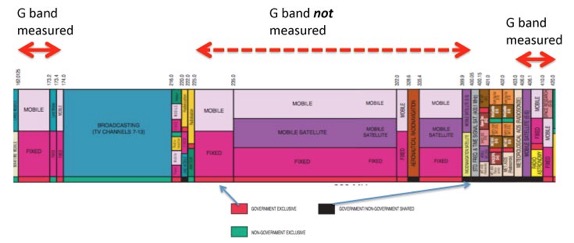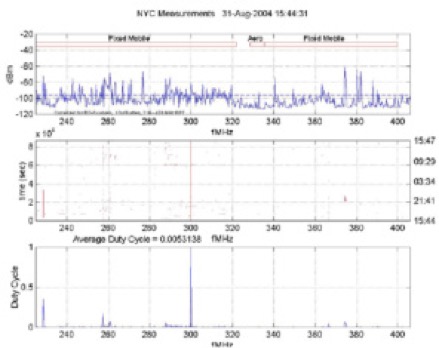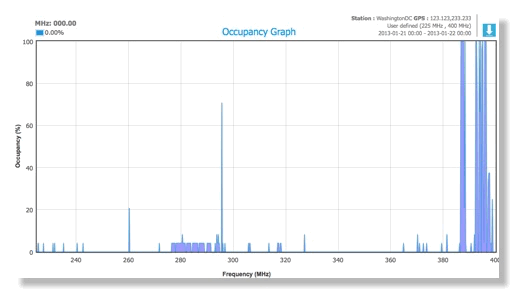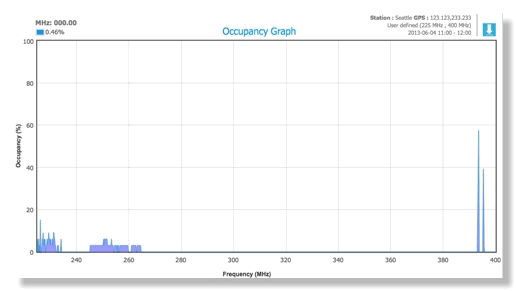MS Spectrum Observatory: Seeing Things NTIA Doesn't Want to See
In August 2010 we published a post here entitled “Does NTIA Have the Bureaucratic Courage to Measure Occupancy of 225-400 MHz?” At the time we used the following chart to show bands NTIA had measured and publicly reported on and the middle band they had carefully ignored.
The 225-400 MHz band is home to many federal systems, but is best known for military aircraft communications. In other countries it is used for civilian aircraft communications and in countries where the US has bases, e.g. Japan and NATO countries, there is tenuous sharing. A fact of US geography is that with the notable exception of San Diego there are no large military airfields in major cities. Thus in geography military spectrum use in this band is generally orthogonal to civil needs for spectrum - that is you rarely see a heavy demand for both military aircraft spectrum and civil spectrum users in the same place.
Long time readers may recall that your blogger has been advocating “interruptible spectrum” use here for a long time. Interruptible spectrum is similar to interruptible electricity. One has access to the resource, but can be preempted from time to time when there is great demand for the resource from users with higher priority.
If your view of cellular communications is people calling 911 then this doesn’t make much sense. But all voice communications is a shrinking faction of cellular traffic and 911 traffic must be microscopic. The great growth in demand for mobile broadband is basically for discretionary services, not safety related services. While the cellular community would like to guarantee all users a high quality of service, there frankly isn’t the spectrum available to do so. Other utilities offer pricing schemes to affect demand with approaches like peak pricing in addition to offering interruptible service at a discounted price. The cellular industry just hasn’t been thinking this way.
But similarly NTIA has not been thinking “out of the box” about efficient use of the natural resource at 225-400 MHz despite new White House thinking. The June 14, 2013 Presidential Memorandum -- Expanding America's Leadership in Wireless Innovation stated:
“Although existing efforts will almost double the amount of spectrum available for wireless broadband, we must make available even more spectrum and create new avenues for wireless innovation. One means of doing so is by allowing and encouraging shared access to spectrum that is currently allocated exclusively for Federal use. Where technically and economically feasible, sharing can and should be used to enhance efficiency among all users and expedite commercial access to additional spectrum bands, subject to adequate interference protection for Federal users, especially users with national security, law enforcement, and safety-of-life responsibilities.”
Does 225-400 MHz meet this test of economic and technical feasibility? The lack of official data on its occupancy discourages commercial interest. (Of course the cellular industry’s impossible goal of only getting spectrum that is available 24/7 in all US territory and can use Chinese-made electronics also discourages interest .) There has been some data available in public reports from Shared Spectrum for several years. (See Note 1 below)The following plot was in an early post here.

In case the August 2004 date doesn’t ring a bell, this data was taken during the 2004 Republican Convention in New York City 3 years after 9/11 when an unprecedented federal law enforcement and military presence was there to protect national leaders. The third plot shows that spectrum use in 225-400 MHz was negligible despite this high federal presence. Other Shared Spectrum publicly available measurements are at their website and show a similar pattern.
There is also data available from the IIT Spectrum Observatory in Chicago which has been making observations since 2007 and storing them. Unfortunately there is not a simple way for researchers to access this data without making detailed arrangements with IIT.
We recently became aware of another resource, the Microsoft Spectrum Observatory which makes observation between 30 and 6,000 MHz in Brussels, Redmond, Seattle, and Washington DC. Unlike the IIT measurements, these are available for online access to anyone!
So how busy is 225-400 MHz in Washington DC and Seattle? In the 2 charts below I picked for the whole day of 1/21/13 in DC, the day of President Obama’s second inauguration and an exceptionally high federal presence. In the case of Seattle I picked 6/4/13, a day I happened to have been there for a conference which I recall was a bright warm sunny day unlike what one expects in Seattle.

Spectrum Occupancy Washington DC 1/21/13 24 hour data (225-400 MHz)

Spectrum Occupancy Seattle WA 6/4/13 1100-1200 (225-400 MHz)
So the cellular industry is not interested in this band because it wants 24/7 nationwide access and the ability to use Chinese-made electronics that meet global standards. Why isn’t FCC and NTIA interested? Repeatedly the problem I hear is that it would complicate the job for DoD spectrum managers stationed overseas who have to explain to our allies why dedicated military channels are needed in this band. The fear is that if DoD doesn’t need 24/7 access to this band in the US, why do they need access in Japan and Europe? This is a real issue but I think it is time to stop holding US spectrum use hostage in order to simplify the job of DoD spectrum managers overseas. The issue here is not reallocating this spectrum to 24/7 commercial use and not using it for 5GHz-like “dynamic spectrum access” that depends on sensing, but rather have a dynamic database system that updates cellular base station in real time which frequencies can be used on a fail-safe basis. Normally base station would have access to much of the band, but as military traffic start building up in an area, blocks would be cleared in anticipation of more traffic so the military traffic would always have what it need plus an additional block of spectrum for rapid surges.

Note 1: There is no detailed generally accepted way to measure occupancy so it is impossible to make precise comparison of measurements. Many decisions have to be made before data is collected and those decisions affect the numbers. Some possible decisions increase apparent occupancy, some decision decrease it. I vividly recall climbing Mt. Fuji in Japan about 15 years ago with my trusty 2m amateur radio. At the top of 12,388' (3,776 m) Mt. Fuji all amateur radio frequencies in the 2m band are fully occupied since the radio horizon includes most of the main island of Honshu! Similarly sensitivity/noise figure, filtering, and 3rd order intercept point decisions affect apparent occupancy. But that said, measurements with very low occupancy show that there is a real issue that should be investigated to confirm or deny whether spectrum is available. Note also that spectrum occupancy measurements usually miss satellite uplink and some downlink transmissions due to their nature. Measurements of full duplex bands with base stations also tend to see the base station downlinks and due to siting can miss the corresponding uplink traffic.
Note 2: How might 225-400 be shared with the private sector? It is clear that any use mobile-based spectrum sharing decision system is not secure enough for the national security uses of this band. Also no listen-before-talk (LBT) cognitive radio system would be reliable enough either. But a base station-based system, typical in today’s cellular systems would place the spectrum selection system in the hands of a few carriers. The carrier spectrum election system could then in turn be controlled in a fail/safe way by DoD spectrum managers to make sure that at a given moment the spectrum is adequate to handle at least (100 + x)% of the authorized DoD traffic. As the DoD traffic approaches the amount set aside for them at a given time in a given area the amount set aside should be increased to maintain a positive margin of available spectrum above demand. Some may argue that the physics of this sharing is similar to the 1755-1850 MHz sharing considered by NTIA’s CSMAC. The D/U ratios discussed there were computed using a primitive propagation that IRAC prefers because it is very conservative. A more balanced consideration of sharing issues under the terms of the 6/13 Presidential Memo would likely give differing answers.
UPDATE
See http://www.marcus-spectrum.com/Blog/files/SpecMeasCorr414.html



![Validate my RSS feed [Valid RSS]](valid-rss-rogers.png)

